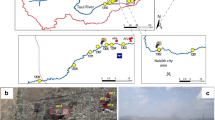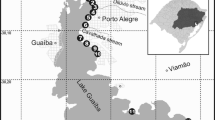Abstract
Sediment traps were deployed in the three major basins of Lake Erie, and the central (Mississauga) basin of Lake Ontario, and refurbished seasonally over the period 2000–2002. In Lake Ontario, sediment down-flux rates and corresponding contaminant down-flux rates were highest in winter during periods of unstratified thermal conditions, and generally increased with depth due to the influence of resuspended bottom sediments during all sampling periods. Lake Ontario suspended sediments exhibited the highest concentrations of metals; concentrations of mercury and lead frequently exceeded guideline values for bottom sediments. Contaminant levels in Lake Ontario suspended sediments were similar to concentrations in bottom sediments in the same area. There was a spatial trend toward higher suspended sediment metals concentrations from the eastern basin to the western basin of Lake Erie, which is similar to the trend in bottom sediment contamination. In the eastern basin of Lake Erie, which is the deepest area of the lake, there was no trend in down-flux rate with depth in 2001; however, down-flux rates increased with depth in 2002. Suspended sediments in the western basin of Lake Erie were determined to be largely resuspended bottom sediments; all western basin samples collected in the study exceeded the guideline value for mercury (0.486 μg/g).
Similar content being viewed by others
References
Baker, J. E., Eisenreich, S. J., & Eadie, B. J. (1991). Sediment trap fluxes and benthic recycling of organic carbon, polycyclic aromatic hydrocarbons, and polychlorinated biphenyl congeners in Lake Superior. Environmental Science & Technology, 25, 500–509.
Ball, D. F. (1964). Loss-on-ignition as an estimate of organic matter and organic carbon in non-calcerous soils. Journal of Soil Science, 15, 84–92.
Beletsky D., Saylor J. H., & Schwab D. J. (1999). Mean circulation in the Great Lakes. Journal of Great Lakes Research, 25, 78–93.
Bogdan, J. J., Budd, J. W., Eadie, B. J., & Hornbuckle, K. C. (2002). The effect of a large resuspension event in southern Lake Michigan on the short-term cycling of organic contaminants. Journal of Great Lakes Research, 28, 338–351.
Canadian Council of Ministers of the Environment (1999). Canadian Environmental Quality Guidelines. Winnipeg, Manitoba, Canada.
Chambers, R. L., & Eadie, B. J. (1981). Nepheloid and suspended particulate matter in southeastern Lake Michigan. Sedimentology, 28, 439–447.
Charlton, M. N. (1975). Sedimentation: Measurements in experimental enclosures. Verh. Int. Verein. Limnol., 11, 267–272.
Charlton, M. N. (1983). Downflux of sediment, organic matter, and phosphorus in the Niagara River area of Lake Ontario. Journal of Great Lakes Research, 9, 201–211.
Dean, W. E. Jr. (1974). Determination of carbonate and organic matter in calcerous sediments and sedimentary rocks by loss on ignition: Comparison with other methods. Journal of Sedimentary Petrology, 44, 242–248.
Durham, R. W., & Oliver, B. G. (1983). History of Lake Ontario contamination from the Niagara River by sediment radiodating and chlorinated hydrocarbon analysis. Journal of Great Lakes Research, 9, 160–168.
Eadie, B. J., Chambers, R. L., Gardner, W. S., & Bell, G. L. (1984). Sediment trap studies in Lake Michigan: Resuspension and chemical fluxes in the southern basin. Journal of Great Lakes Research, 10, 307–321.
Gasith, A. (1975). Tripton sedimentation in eutrophic lakes – simple correction for resuspended matter. Verh. Int. Verein. Limnol., 19, 16–122.
Marvin, C. H., Alaee, M., Painter, S., Charlton, M., Kauss, P., Kolic, T. et al. (2002a). Persistent organic pollutants in Detroit River suspended sediments: Polychlorinated dibenzo-p-dioxins and dibenzofurans, dioxin-like polychlorinated biphenyls and polychlorinated naphthalenes. Chemosphere, 49, 111–120.
Marvin, C. H., Charlton, M. N, Reiner, E. J., Kolic, T., MacPherson, K., Stern, G. A. et al. (2002b). Surficial sediment contamination in Lakes Erie and Ontario: A comparative analysis. Journal of Great Lakes Research, 28, 437–450.
Marvin, C. H., Charlton, M. N., Stern, G. A., Braekevelt, E., Reiner, E. J., & Painter, S. (2002c) Spatial and temporal trends in sediment contamination in Lake Ontario. Journal of Great Lakes Research, 29, 317–331.
Marvin, C. H., Sverko, E., Charlton, M. N., Thiessen, P. A., & Painter, S. (2004). Contaminants associated with suspended sediments in Lakes Erie and Ontario, 1997–2000. Journal of Great Lakes Research, 30, 277–286.
Mudroch, A. (1993). Lake Ontario sediments in monitoring pollution. Environmental Monitoring and Assessment, 28, 117–129.
Oliver, B. G., & Charlton, M. N. (1984). Chlorinated organic contaminants on settling particulates in the Niagara River vicinity of Lake Ontario. Environmental Science & Technology, 18, 903–908.
Oliver, B. G., Charlton, M. N., & Durham, R. W. (1989). Distribution, redistribution, and geochronology of polychlorinated biphenyl congeners and other chlorinated hydrocarbons in Lake Ontario sediments. Environmental Science & Technology, 23, 200–208.
Painter, S., Marvin, C., Rosa, F., Reynoldson, T., Charlton, M., Fox, M. et al. (2001). Sediment contamination in Lake Erie: A 25-year retrospective analysis. Journal of Great Lakes Research, 27, 434–448.
Sandilands R. G., & Mudroch A. (1983). Nepheloid layer in Lake Ontario. Journal of Great Lakes Research, 9, 190–200.
Thomas, R. L., Kemp, A. L. W., & Lewis, C. F. M. (1972). Distribution, composition and characteristics of the surficial sediments of Lake Ontario. Journal of Sedimentary Petrology, 42, 66–84.
Author information
Authors and Affiliations
Corresponding author
Rights and permissions
About this article
Cite this article
Marvin, C., Charlton, M., Milne, J. et al. Metals Associated with Suspended Sediments in Lakes Erie and Ontario, 2000–2002. Environ Monit Assess 130, 149–161 (2007). https://doi.org/10.1007/s10661-006-9385-4
Received:
Accepted:
Published:
Issue Date:
DOI: https://doi.org/10.1007/s10661-006-9385-4




